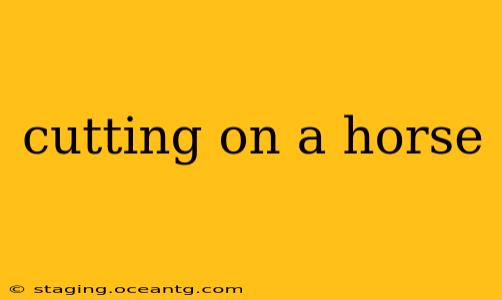Cutting is a fast-paced, exhilarating equestrian sport that showcases the incredible bond between horse and rider. It demands exceptional skill from both partners, testing the horse's athleticism, intelligence, and responsiveness, as well as the rider's precision and understanding of cattle behavior. This guide delves into the intricacies of cutting, answering common questions and providing insights into this captivating discipline.
What is Cutting?
Cutting is a rodeo event where a single horse and rider work together to separate one cow from a herd. The rider must skillfully maneuver their horse to prevent the cow from rejoining the herd for a set period, typically 2 minutes and 30 seconds. The horse performs most of the work, demonstrating agility, quickness, and an innate ability to read the cow's movements. The rider's role is to guide and support the horse, using subtle cues to maintain control and keep the cow isolated. Points are awarded based on the horse's ability to control the cow, its responsiveness to the rider, and the overall performance.
What Makes a Good Cutting Horse?
A truly exceptional cutting horse possesses a unique combination of traits:
- Cow Sense: This innate ability to read and anticipate a cow's movements is paramount. The horse must instinctively know how to position itself to effectively cut the cow away from the herd.
- Agility and Quickness: Cutting requires explosive bursts of speed and agility to quickly change direction and maintain control of the cow.
- Athleticism and Stamina: The sport is physically demanding, requiring the horse to maintain intense focus and exertion for the duration of the run.
- Responsiveness and Trainability: A good cutting horse must be highly responsive to the rider's subtle cues, exhibiting a strong work ethic and a willingness to learn.
How is a Cutting Horse Trained?
Training a cutting horse is a long and dedicated process, often spanning several years. It involves:
- Groundwork: Building a strong foundation of respect, trust, and obedience through basic groundwork exercises.
- Cattle Work: Gradually introducing the horse to cattle, starting with controlled settings and progressively increasing the complexity of the challenges.
- Refinement: Fine-tuning the horse's skills and responsiveness through repeated practice and refinement of techniques.
- Professional Guidance: Experienced trainers play a crucial role in guiding the horse and rider through the training process.
What are the Different Levels of Cutting Competition?
Cutting competitions offer a range of levels, catering to horses and riders of varying skill levels. These often include:
- Youth Classes: Designed for younger riders to participate and develop their skills.
- Amateur Classes: For non-professional riders.
- Open Classes: The highest level of competition, featuring professional riders and their highly trained horses.
What Equipment is Used in Cutting?
Cutting horses are typically ridden in a western saddle, with specialized equipment designed for this specific discipline.
- Western Saddle: Offers stability and support for the rider.
- Cutting Bit: A specific type of bit designed to provide responsive control without being harsh.
- Spurs: Used for subtle cues and added control, although the use and application vary greatly amongst competitors.
What are Some Famous Cutting Horses?
Many legendary cutting horses have left an indelible mark on the sport. Their names are often synonymous with excellence and championship titles, inspiring future generations of cutting horse enthusiasts. Researching these horses provides valuable insight into the qualities that make a champion.
How Can I Get Started in Cutting?
If you're interested in pursuing this exciting sport, finding a reputable cutting horse trainer is crucial. They can guide you through the training process, provide valuable expertise, and help you find a suitable horse. Remember that dedication, patience, and a genuine love for the sport are key ingredients to success.
This comprehensive guide provides a solid foundation for understanding the captivating world of cutting. Remember to further your research and explore resources dedicated to the specific techniques and nuances of this thrilling equestrian discipline.
